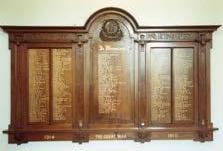
4 minute read
From the Archives
March 2020
In my capacity as School Historian I have recently completed a history of the School in the First World War – Sustaining the Glorious Empire: Camberwell Grammar and the Great War, 1914-18.” This history of a sad time in the past of our School and nation is now available online and in hard copy. As mentioned in the history, the pictured Honour Board with the 245 names of Old Boys who had served was unveiled at the School in November 1920.
‘Sustaining the
Glorious Empire’ Camberwell Grammar and the Great War 1914–18
Dr David S. Bird – School Historian
The project that I have now undertaken is examining the history of the first six headmasters of Camberwell Grammar, beginning with Arthur Taylor in 1886 and concluding with the retirement of the Reverend Timpson in 1966. My focus is not only to provide an aspect of the history of the School in these first eight decades, but chiefly to examine the character of these men and their roles in the development of the institution they headed. I am conscious of the warning provided by Anthony Trollope in 1880 when this renowned novelist turned his attention to biography:
In discussing the character of a man, there is no course of error so fertile as the drawing of a hard and fast line. We are attracted by salient points and seeing them clearly we jump to conclusions, as though there were a lighthouse on every point by which the nature of the coast would certainly be shown to us. And so it will if we accept the light only for so much of the shore as it illumines.
Nevertheless, the lives of these men before they assumed office at Camberwell Grammar, during their time as headmaster and later, are clearly of great interest to anybody interested in the story of our learning community. I am currently researching the story of Arthur Bertram Taylor, the entrepreneurial educator who founded the School in February 1886, at first in the modest conditions of St John’s Church near the Camberwell Junction, then proceeding to the more comfortable environment of Fermanagh Road, Prospect Hill. His early life prior to the establishment of his own ‘private’ school – from the time of his English birth (in August 1857) and his arrival in Victoria in the following year to the opening of the School’s doors on that Tuesday in February 1886 – makes a fascinating story, so typical of the booming colonial society in which he lived. The new “Head Master” [sic] was only twentyeight-years old, but he was already an accomplished businessman, property developer and schoolmaster by 1886. His father, George Taylor, was a prominent solicitor and local councillor in the Boroondara district and had constructed a very comfortable residence set off Burke Road, Canterbury, in 1865 in which Arthur, the youngest of what would number six surviving children, had lived whilst attending Scotch College as a boy and the University of Melbourne as a young man. He returned to this property, “Mountfield” (pictured), briefly in 1886 following a domestic tragedy, so the building is an interesting component in the account of his life and of his School, now located only a short distance from the site of this villa.

The original address of this property was listed as ‘Survey Road’ as Mont Albert Road was then known, some indication of the relative meagre development of the area at that time. “Mountfield” was a typical upper middle-class brick villa of the period with its mandatory English name and mock-Tudor, “cottage orné” style, set amongst valuable ten acres as a ‘farmlet’ at a time when smaller suburban blocks with a sixty-foot frontage were being sold for £1,500 (well in excess of $200,000 by today’s standards which in many respects complement those of “Marvellous Melbourne” prior to the 1890s crash). The property was enclosed within the presentday streets of Mont Albert Road in the north, Burke Road in the west, Woodstock Street in the south and Parlington Street in the east. The “Mountfield” block was sub-divided following George’s death (aged 65) in October 1886, the former driveway becoming Mountfield Street. The property was then described as ‘commanding the most magnificent views within six miles of Melbourne [with] the finest Oak and Elm trees in the colony’. There were no native trees, offering the Taylors and their successors an accurate reproduction of life in the Old Country. A large part of the land was acquired by the Grey Sisters Order, still in situ at no.6 Mont Albert Road. “Mountfield” itself had passed through various private hands but was purchased by the Order in 1945 for the handsome price of £12,000 (just under $900,000 by today’s figures), then used as part of the O’Connell Family Centre for over half-a-century, the ballroom being converted into chapel. Following further sub-division, “Mountfield” was purchased by the Camberwell Girls Grammar School in 2006, utilising it as a component of their Junior School. It is a fine building which still offers the impression of Victorian prosperity and bourgeois solidity with its stained glass and accomplished woodwork interior. The archivist of CGGS, Ms Melissa Campbell, recently allowed me to tour the building and to experience the ambience that buildings of such character possess.

“Mountfield” is simply the first fortunately surviving structure that will allow me to cast some of Trollope’s illuminating light on the early history of the School under the guidance of its founder, A.B. Taylor, a man of vision and enterprise whose role in the story of Camberwell Grammar has not received the attention it deserves.






